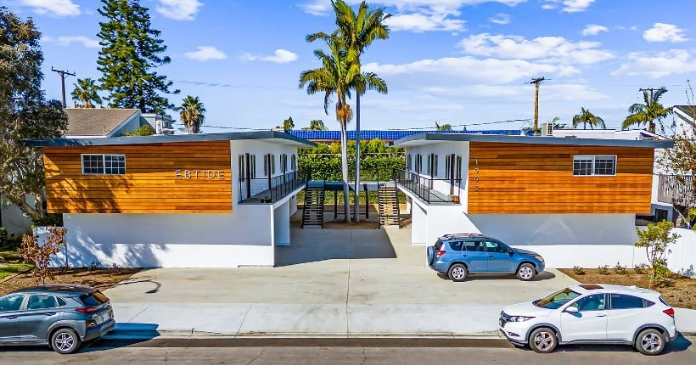The CEOs of Memphis-based Mid-America Apartment Communities, Inc. (MAA) and Birmingham-based Colonial Properties Trust, respectively, believed their companies combined would be better than two standalone entities.
So, on Oct. 1, after 20 years as friendly competitors in the Sunbelt, they joined forces to create the largest multifamily REIT platform focused on the region.
“I was always optimistic that if the conditions supported it and the timing was right, a merger of the two companies would occur,” said Bolton.
The merger followed the mega-sale of Archstone Smith assets to Equity Residential (EQR) and AvalonBay Communities, Inc. (AVB), two apartment REITs that teamed up to purchase the former REIT’s apartment properties from the banks that owned them. That deal closed on February 27.
While there have been a number of IPO’s and public-to-private sales, REIT mergers have been surprisingly lacking in the apartment space. The last such transaction likely was Colonial’s takeover of Cornerstone Realty Trust in 2005, which more than doubled the multifamily segment of Colonial’s diversified portfolio.
With the ink dry on the MAA/Colonial transaction, MAA is the second largest U.S. apartment REIT with 85,000 units compared to 117,322 units owned by EQR, the largest apartment REIT by total market cap. AVB is the nation’s third largest with 81,499 apartments.
MAA retains its name and Memphis headquarters and Bolton continues as Chairman and CEO. Lowder joins the new board that includes five Colonial board members. He notes this deal puts to rest questions surrounding Colonial CEO succession.
Team effort
Management at both companies worked hard through the summer to complete a successful closing of the merger. Over the past few years, the Colonial team simplified their company’s business model with a more oriented focus on multifamily by selling off commercial properties and boosting the REIT’s percentage of NOI from its core multifamily business to 95 percent, thus paving the way for easier integration with MAA. Today, virtually every commercial asset in its legacy portfolio is on the market for disposition.
Colonial also lowered the overall age of its apartment portfolio with the sale of three older assets and reduced its land inventory with the sale of for-sale residential land, using the proceeds to reduce outstanding debt.
MAA helped facilitate the merger by gaining access over the past few years to the unsecured debt market, distancing itself from the GSEs at a time when their future remains in question.
The REIT renewed its unsecured revolving credit facility in the first quarter with improved terms and increased borrowing capacity and, post merger, completed its inaugural unsecured offering of $530 million of public bonds, with a 4.3 percent coupon price, with plans to execute another such offering next year.
Coupled with additional unsecured obligations assumed in the Colonial merger, MAA’s balance sheet has successfully transitioned from being a secured borrower to that of a traditional unsecured issuer, a move that should help the now larger and even stronger REIT weather any increase in move-outs or supply-side pressure in the Sunbelt.
Keys to success
Controlled spending, careful due diligence, a steadfast focus on diversified markets and a careful eye towards limiting balance sheet risk are the practices that have led MAA to outperform its peers on same-store growth during the recent downturn and over the past decade, and helped set MAA apart in the industry.
These strategies also help offset MAA’s risk of operating in the nation’s commodity markets, where land is readily available and a builder can entitle and deliver a new apartment community within 18 months, making the Sunbelt particularly prone to supply pressure from cyclical overbuilding—all reasons many of MAA’s REIT peers avoid the region.
Key to the REIT’s success in the Sunbelt is its diversification across both large (or primary) and secondary markets, and its culture built around a robust and sophisticated property management operation.
Colonial brought assets to MAA that are more heavily weighted in the larger, higher growth markets. While these markets potentially expose the REIT to supply pressures, they also provide manufacturing jobs at companies like Boeing, Volkswagen, Gulfstream and General Dynamics.
MAA uses jobs to supply a ratio as a barometer to assess how weak or strong a market’s going to be and how much supply it faces. Colonial’s ratio of large to secondary markets moves MAA up from about 55 percent large, 45 percent secondary, based on legacy MAA, to 60 percent large and 40 percent secondary, as a result of the merger.
“We think it appropriate to allocate and weight a meaningful portion of our capital in large markets where you perhaps have a bit more exposure to supply but you also have stronger long-term demand. So, on balance, we are a bit more exposed to higher growth markets as a consequence of the merger and we are glad of it,” said Bolton.
In Q3, leasing remained strong across MAA’s large market segment, including Houston, Dallas, Austin and Nashville. But next year, new supply deliveries are likely to impact MAA’s ability to raise rents. If that happens, the REITs secondary markets segment should provide a stabilizing influence on the overall portfolio.
MAA is sensitive to market weightings and generally limits exposure to any given market to around 10 percent. “We are pretty big right now in Dallas and Charlotte. My guess is there will be some recycling next year as we continue to move out of the lower margin investments into higher margin investments. If there is a market to be heavy in, Dallas and Charlotte are not bad ones, but we’ll look to probably recycle a little bit there,” said Bolton.
To ensure MAA continues to refresh the portfolio with high-margin investments, Bolton expects a reasonable annual run-rate for recycling will be $150 million to $200 million. MAA exited five secondary markets this year.
Supply issue debunked
Even with more deliveries expected in the Sunbelt, Bolton is not overly concerned with supply over the next four or five years, during which projected job growth in MAA’s markets is clearly 80 basis points ahead of expected U.S. averages.
“The access to more information and greater transparency on permitting trends and forecasts suggest that the periods of wildly excessive overbuilding that has occurred in the past is less likely to occur today,” said Bolton.
He thinks the Sunbelt has gotten a bad rap in comparison to the high barrier markets on both coasts.
“While occasional periods of new supply coming on-line in a given market can cause some moderation in the demand-supply ratio, it is not as if periods of oversupply are somehow isolated to the Sunbelt markets. We have certainly witnessed periods of excess supply in so-called high-barrier markets over the past couple of years,” he said.
Bolton points to conditions in the Sunbelt that support economic expansion and job growth that typically outpace the national average. These include lower cost of living, lower taxes, ample incentives from cities and states to businesses and employers to expand and relocate, great education facilities, moderate weather and generally great quality of life, all of which continue to drive economic growth across the region.
“Our investment horizon in acquiring or building properties extends well beyond just a few years. We believe it is better to be invested in the Sunbelt, where the demand for apartment housing is more likely to be stronger and consistently growing. It’s important to deploy capital and operate with awareness there will be times of potential new supply and to plan for it.
“These trends will continue to attract employment opportunities and young adults to the region, spurring the development of entertainment venues and outdoor activities that are important to the 20- to 35-year-old Gen Y demographic,” he said.
Realized synergies
MAA expects $60 million in merger-related costs in the fourth quarter, but also expects to realize $25 million in synergies as a result of the transaction over the next 18 months, as well as additional savings that have yet to be quantified.
“The expense savings to be captured from the merger generally fall into two broad categories; corporate overhead and multi-site operations. In general, given the high degree of overlap between the two companies, both in terms of real estate focus and markets, we believe there is meaningful opportunity to eliminate duplicated costs and, in general, drive more efficiency.
“In addition, we expect that over time there will be opportunities surrounding the ability to capture greater efficiency with onsite operations as we fully integrate systems, policies and practices,” said Bolton.
MAA already is realizing benefits from systems overlap, as well as from Colonial’s experience transitioning to the Yardi property management system, which MAA will also begin using across its legacy portfolio in the first half of 2014.
Both companies already use LRO, the revenue management system that offers a number of options in defining how the system will react to market information and trends, property specific status, seasonal leasing traffic patterns and particular unit attributes.
Acquisitions front
One of MAA’s core strengths is on the acquisitions front. As an all-cash buyer, it has the ability to provide competitive pricing to developers and sellers and can move quickly in a transaction without being slowed by lender negotiations or lengthy due diligence.
MAA is comfortable executing on $400 million or more in a given year if the opportunities meet the REIT’s underwriting hurdles.
But, despite this healthy appetite for growth and the REIT’s close to 20 years of established performance on acquisitions, MAA had a tough time beating out the institutional investors that are its main competitors this year. Management expects acquisition volume for the year to come in somewhere between $175 million to $225 million.
“We are willing to commit a fair amount of resources to thorough due diligence early in the process such that when we provide a quote it is a firm number. So, if we lose an opportunity, it is largely due to another investor’s willingness to pay more than what we were willing to pay for a given property based on either more aggressive underwriting or forecasting assumptions, or a willingness to accept a lower investment return,” said Bolton.
He expects to realize some opportunistic acquisitions as sellers become anxious in the wake of new supply.
“With talk of more supply coming into the marketplace, we’ll find developers who increasingly want to talk about a pre-purchase contract that allows them to get their exit risk off the table. On a non-marketed basis, we are able to come in, offer them an exit and bring new assets onto the portfolio at attractive pricing,” said Bolton.
Risky business
Although MAA plans to keep an active pipeline of $200 million to $250 million of new development at all times, the REIT continues to have faith in its model built around the notion of outsourcing risk through pre-purchase commitments with developers, or transactions where the property is already under construction.
At this point in the market cycle, where new supply began picking up last year, MAA is not interested in starting a significant number of new developments.
With the REIT’s ready access to capital, Bolton would rather start a project earlier in the cycle at a time when other developers are finding it tough to get financing, thus reducing MAA’s risk of inducing higher development costs, slower lease-ups and, ultimately, lower returns for its investment.
MAA likely will target the vibrant high-growth secondary markets for what little development activity the company takes on.
“The idea of building in Dallas or in Atlanta, I kind of step back and say, ‘Why?’ I mean, let others do that. There is plenty of it that happens and I’d rather be an opportunistic buyer in those markets. Over time we believe we can opportunistically acquire new assets at yields and IRRs in those markets comparable to those we’d achieve as a developer, without the risks.
“But take a secondary market like Charleston, as an example, where we did a pre-purchase development deal. We got most of the units this quarter and the darn thing is already 86 percent leased. It’s unbelievable in some of these strong secondary markets what you can do,” said Bolton.
With four development projects added in the Colonial merger as well as undeveloped land, the REIT has a total of six properties under construction with a total pipeline of 1,731 units.
But Bolton plans to sell the land bank that Colonial brought to the merger. “We believe it makes sense to go ahead and recycle the capital and get it productive in earnings assets. If a particular developer is interested in buying the land we are selling, with an opportunity for MAA to later acquire the newly built community, we would certainly be interested in such a transaction.
“Having the Colonial development team on staff provides both an opportunity to source more of these sorts of deals, as well as expanded expertise to oversee and monitor the development and construction that is underway,” said Bolton.
Another area of opportunity for MAA is its redevelopment program. The REIT has had positive results from this business and will look at expanding it to include some of the Colonial assets. During 2012, a total of 3,236 units were upgraded at an average cost of approximately $4,300 per unit, achieving rental rate increases of 10 percent above non-renovated units. A typical unit redo includes upgrades to kitchens and baths.
“We are currently planning a number of test units across the former Colonial properties and believe that 30 to 40 percent of the portfolio provides an opportunity for unit interior redevelopment. We are capturing very attractive returns on the redevelopment program underway in the legacy MAA portfolio and are excited about the potential within the legacy Colonial portfolio,” said Bolton.
A new brand
When it comes to maintaining a high profile MAA brand, the company aims to create a unified look in the leasing offices, but stops short of spending on new signage across the Colonial legacy portfolio.
“We believe that as the merger integration proceeds there will be opportunities to further strengthen and build on the MAA brand. We don’t believe it is necessary or worth the expense to pursue a plan to name all communities in a like manner.
“Our focus on branding is based on operating consistency and how we interact with our prospective and existing residents. Ultimately, our goal is to ensure that the constituents we serve—our residents, our shareholders and our associates working at MAA—can expect a consistently positive and value-add relationship with our company,” said Bolton.















